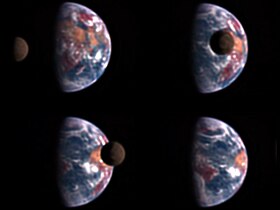
The Moon is a a quarter the diameter of the Earth and 1/81 its mass,[2] making it the largest moon in the solar system relative to the size of its planet (although Charon is larger relative to the dwarf planet Pluto).[3]
However, the Earth and Moon are still considered a planet–satellite system, rather than a double-planet system, as their barycentre, the common centre of mass, is located 1,700 km (about a quarter of the Earth's radius) beneath the surface of the Earth.[4]
The Moon's surface area is less than one-tenth that of the Earth; about a quarter of the Earth's land area.
- ^ Astronomy Picture of the Day, 2008 September 3
- ^ Spudis, P.D. (2004). "Moon". World Book Online Reference Center, NASA. Retrieved 12 April 2007.
- ^ "Space Topics: Pluto and Charon". The Planetary Society. Retrieved 6 April 2010.
- ^ "Planet Definition Questions & Answers Sheet". International Astronomical Union. 2006. Retrieved 24 March 2010.